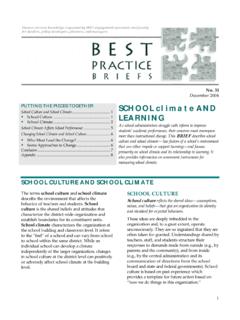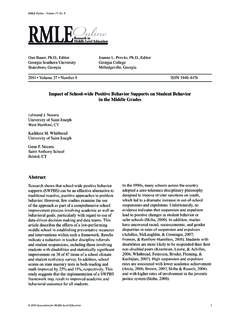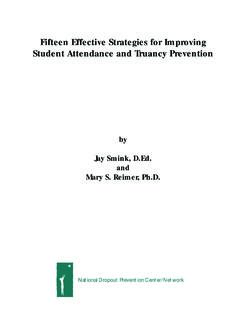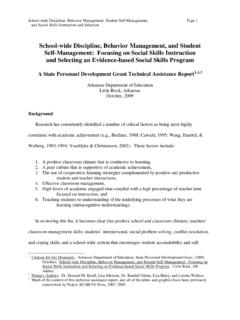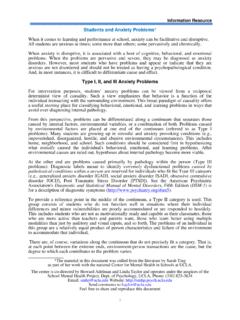Transcription of PUTTING THE PIECES TOGETHER SCHOOL climate AND …
1 1 No. 31 December 2004 PUTTING THE PIECES TOGETHER SCHOOL Culture and SCHOOL 1 SCHOOL Culture .. 1 SCHOOL climate .. 2 SCHOOL climate Affects SCHOOL Performance .. 5 Changing SCHOOL climate and SCHOOL 6 Who Must Lead the Change? .. 6 Some Approaches to 6 7 8 SCHOOL climate AND LEARNING As SCHOOL administrators struggle with reform to improve students academic performance, their concerns must encompass more than instructional change. This BRIEF describes SCHOOL culture and SCHOOL climate two factors of a SCHOOL s environment that can either impede or support learning and focuses primarily on SCHOOL climate and its relationship to learning.
2 It also provides information on assessment instruments for measuring SCHOOL climate . SCHOOL CULTURE AND SCHOOL climate The terms SCHOOL culture and SCHOOL climate describe the environment that affects the behavior of teachers and students . SCHOOL culture is the shared beliefs and attitudes that characterize the district-wide organization and establish boundaries for its constituent units. SCHOOL climate characterizes the organization at the SCHOOL building and classroom level. It refers to the feel of a SCHOOL and can vary from SCHOOL to SCHOOL within the same district.
3 While an individual SCHOOL can develop a climate independently of the larger organization, changes in SCHOOL culture at the district level can positively or adversely affect SCHOOL climate at the building level. SCHOOL CULTURE SCHOOL culture reflects the shared ideas assumptions, values, and beliefs that give an organization its identity and standard for expected behaviors. These ideas are deeply imbedded in the organization and, to a great extent, operate unconsciously. They are so ingrained that they are often taken for granted. Understandings shared by teachers, staff, and students structure their responses to demands made from outside ( , by parents and the community), and from inside ( , by the central administration and its communication of directions from the SCHOOL board and state and federal governments).
4 SCHOOL culture is based on past experience which provides a template for future action based on how we do things in this organization. 2 Components of SCHOOL Culture Culture is reflected in an organization s atmosphere, myths, and moral code. The characteristics of a SCHOOL district s culture can be deduced from multiple layers: Artifacts and symbols: the way its buildings are decorated and maintained Values: the manner in which administrators, principals and staff function and interact Assumptions: the beliefs that are taken for granted about human nature As a SCHOOL district s culture develops over time, it is maintained by several practices.
5 Common beliefs and values that key individuals communicate and enforce Heroes and heroines whose actions and accomplishments embody these values Rituals and ceremonies that reinforce these values Stories that reflect what the organization stands for1 The following chart shows how these components of SCHOOL culture can support or impede learning. SCHOOL culture that .. Supports Learning Impedes Learning Artifacts and symbols The building and its arrangements reflect the children, their needs, and their educational accomplishments.
6 There is little that reflects an emphasis on children and their education. Values Administrators, teachers, students , and parents participate in decision making. Decisions are made without participation of teachers and parents. Assumptions and beliefs All students can learn. Parents want their children to succeed. Parents are partners in education. Some students are incapable of learning or too lazy to learn. Parents don t care. Parents know nothing about education. SCHOOL climate SCHOOL climate reflects the physical and psychological aspects of the SCHOOL that are more susceptible to change and that provide the preconditions necessary for teaching and learning to take place.
7 SCHOOL climate , the focus of this BRIEF, is evident in the feelings and attitudes about a SCHOOL expressed by students , teachers, staff and parents the way students and staff feel about being at SCHOOL each SCHOOL climate is a significant element in discussions about improving academic performance and SCHOOL reform. It is also mentioned in discussions of potential solutions to problems such as bullying, inter-student conflicts, suicide, character education, and moral education. Components of SCHOOL climate Although there is no consistent agreement in the literature on the components of SCHOOL climate or their importance, most writers emphasize caring as a core element.
8 However, some place safety foremost,2 defining SCHOOL climate as an orderly environment in which the SCHOOL family feels valued and able to pursue the SCHOOL s mission free from concerns about disruptions and safety. Several aspects of a SCHOOL s physical and social environment comprise its climate . One organization identified the following eight areas: Appearance and physical plant Faculty relations Student interactions Leadership/decision making 3 Disciplined environment Learning environment Attitude and culture SCHOOL -community relations3 The comprehensive view used in this BRIEF, and summarized below, defines SCHOOL climate in terms of four aspects of the SCHOOL environment.
9 A physical environment that is welcoming and conducive to learning A social environment that promotes communication and interaction An affective environment that promotes a sense of belonging and self-esteem An academic environment that promotes learning and self-fulfillment1 A Physical Environment that is Welcoming and Conducive to Learning Supports Learning SCHOOL building contains a limited number of students . students are, and feel, safe and comfortable everywhere on SCHOOL property. Classrooms are orderly. Classrooms and grounds are clean and well-maintained.
10 Noise level is low. Areas for instruction and activities are appropriate for those uses. Classrooms are visible and inviting. Staff members have sufficient textbooks and supplies. Impedes Learning SCHOOL building contains a large number of students . students are harassed by other students in halls, restrooms, lunch rooms, or playgrounds. Classrooms are disorganized. Classrooms and grounds are dirty, poorly lit, and poorly maintained. Noise level is high. Classrooms are in rooms not intended for that use. Space is overcrowded.
